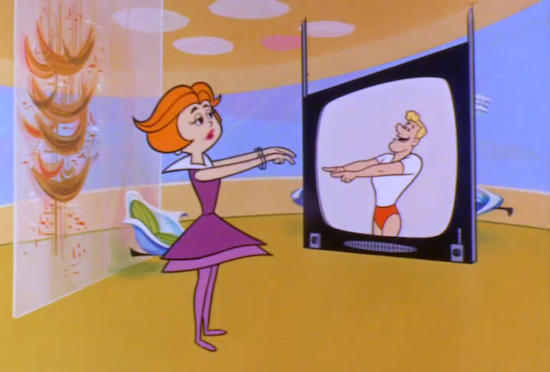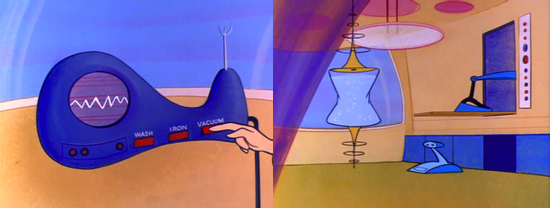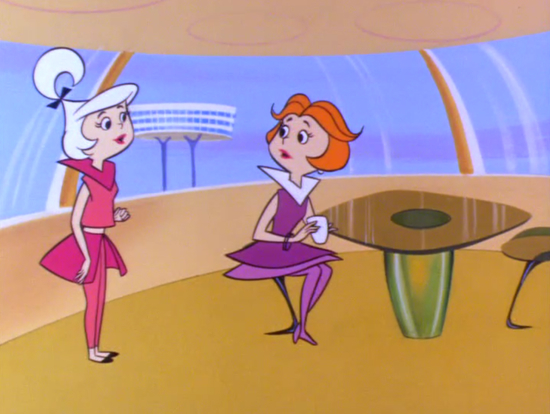From Smithsonian Magazine's Paleofuture blog:
Jane Jetson working out her strained fingers in the premiere episode of “The Jetsons” (1962)
This is the first in a 24-part series looking at every episode of “The Jetsons” TV show from the original 1962-63 season.
Episode 01: “Rosey the Robot,” originally aired: September 23, 1962
If you flipped through the
Cedar Rapids Gazette on September 23, 1962 the news looked fairly typical for the early 1960s.
There was a short item about a Gandhi memorial being planned in
London. There was an article about overcrowded schools and the need for
new junior high schools, since the
baby boom
had inundated the schools and enrollment in the Cedar Rapids public
school system was increasing by about 1,000 students each year.

Newspaper ad for color TV in the September 23, 1963 Cedar Rapids Gazette
The
Gazette also had an editorial about “lame-brain bigots”
in Georgia who were burning down black churches, and a column about the
fact that one out of every 38 children born in
Linn County
in 1961 was born out of wedlock. The paper had recipes for poached eggs
and peas with lemon butter sauce, as well as ads for the Smulekoff’s
furniture store imploring you to buy a brand new color TV—with prices
starting as low as $495 (about $3,500 adjusted for inflation).
But tucked away within the TV listings for that week was the mention
of a show that would radically shape the way Americans would talk about
the future for decades to come. The newspaper had an article about the
arrival of color on ABC’s Cedar Rapids affiliate, KCRG channel 9. NBC
had been “carrying the color ball almost singlehandedly” for years in
Cedar Rapids but starting that evening, ABC would join the color fray
with a new show called “The Jetsons.” At 6:30 pm that night “The
Jetsons” would debut against “Dennis the Menace” on channel 2, “Car 54
Where Are You?” on channel 6, and the season premiere of NBC’s immensely
popular “Walt Disney’s Wonderful World of Color” on channels 7 and 13.
Of course, it wasn’t just the people of Cedar Rapids who were tuning
in on Sunday to watch a middle class family stumble through modern life
in the year 2062. People all over the United States got their first
taste of the Jetsons’ vision for tomorrow on that autumn evening.
Push-Button Living
There’s perhaps nothing more Jetsonian than the push-button. Jane
Jetson pushes buttons to make dinner, to clean the home, and even to
wake up her husband George. The running gag throughout the entire series
is that the only thing George does all day at work (all three hours of
it) is push a button.
From the very first scene of the first episode we learn precisely how
difficult the people of the future have it. Jane Jetson is standing in
front of a flat panel “3D” TV and conducting a strenuous workout — of
her fingers. Of course, we’re meant to laugh at the fact that people of
the year 2062 are living in the lap of luxury needing only push a button
to accomplish what used to take hours, but it was also a subtle jab to
those viewers at home who may complain about how difficult life is when
all the modern conveniences of 1962 were at their disposal.
It’s important to recall that some scholars have argued that modern
appliances didn’t actually save nearly as much time as originally
envisioned. That’s because these gadgets impose higher standards of
household efficiency and cleanliness—we take it for granted that our
closets will always be filled with clean clothes; that our yards should
boast perfectly maintained lawns and gardens; that our shiny kitchen
appliances will make it possible to enjoy diverse and tasty meals. Many
people today question this same line of thinking about technological
progress, arguing that computers and smartphones have made us more
productive, but that the standards for how much one person needs to
accomplish have simply risen with it. Not to mention the “
always available” culture that our devices have cultivated.
Two screenshots from The Jetsons showing Jane Jetson doing housework
While we often associate leisurely push-button living with the Jetsons, longtime readers of
Paleofuture will know that this futuristic cartoon family didn’t invent the concept. In December 1950 an
Associated Press article
ran in newspapers across the country that gave readers a peek at the
year 2000. Experts across all kinds of fields were consulted and the
article took it as a given that the American home of the future would be
much more automated than it was mid-century:
People will live in houses so automatic that push-buttons
will be replaced by fingertip and even voice controls. Some people
today can push a button to close a window – another to start coffee in
the kitchen. Tomorrow such chores will be done by the warmth of your
fingertip, as elevators are summoned now in some of the newest office
buildings – or by a mere whisper in the intercom phone.
But, as is often the case in the Jetsons’ world, the gadgets of
tomorrow in the premiere episode don’t always work as they were
intended. Gadget malfunction is rampant and a source of financial stress
in the Jetson home, recalling an article in the
Chicago Tribune Sunday Magazine just a few years earlier.
Writing in the September 13, 1959
Chicago Tribune, Evelyn
Zemke projects herself into the futuristic world of the year 2000. The
“pizza for breakfast?” bit is nearly identical to what we see play out
in the Jetson household during the premiere episode.
“Call a service man,” my husband always says when one of our appliances refuses to function.
Sounds simple enough, doesn’t it? Well, it is. At the very worst,
probably only the washer, dryer, dishwasher, and TV would give up one
day. But what about the housewife of the future – say of the year 2000,
when the electronic era will be at its peak?
I can just picture myself in her place - ready to start another
care-free day sitting around reading a science fiction thriller while
the gadgets do all the work. Already the electronic brain in my kitchen
is busy preparing and serving breakfast.
My husband, arriving at the table exclaims, “Pizza? For breakfast?”
“I pushed the button labeled BACON AND EGGS, but-”
“There’s a wire crossed somewhere. Call a service man.”
After doing so, I dispose of the garbage in the electronic disposal
unit and pile the dishes in the ultra-sonic dishwasher. Then, after
pushing the button which starts the electronic vacuum cleaner, I go out
to the garage to set the timer for our radar controled lawnmower.
“Ki-yi-yi!” Sounds like Fifi, our pet poodle.
My daughter, standing in the doorway, calls, “Mom! The cleaner is vacuuming Fifi!”
Judy and her mother Jane Jetson in their home in the premiere episode “Rosey the Robot”
Baby Boom
The premiere episode also shows viewers an interaction with Jane and
her daughter Judy that hints at what would later be called the
generation gap.
Many of the same fears parents have here in the 21st century about
their kids “growing up too fast” were splashed across popular media of
the 1960s. The August 10, 1962 issue of
Life magazine ran the
story “Boys and Girls Too Old Too Soon: America’s Subteens Rushing
Toward Trouble.” The story included a provocative photo essay showing 12
and 13-year-olds going on dates and engaging in “heavy necking.”...
MUCH MORE






 (AP Photo/Andre Penner)
(AP Photo/Andre Penner)












